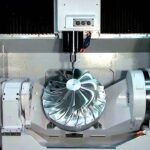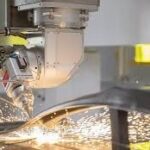
5-Axis Manufacturing represents a significant leap forward in the world of precision engineering, transforming how complex parts are designed and produced. It’s not just an upgrade from traditional machining; it’s a paradigm shift that unlocks unprecedented design freedom and efficiency.
Beyond the Basics: Understanding the “Fifth Dimension”
5-Axis Manufacturing Imagine crafting a complex shape, like a turbine blade or a medical implant. Traditional 3-axis machining limits you to moving the cutting tool along three linear axes: left-right (X), front-back (Y), and up-down (Z). This restricts the angles at which you can approach the workpiece, often requiring multiple setups and compromising precision.
5-axis manufacturing introduces two additional rotational axes. These axes, often labeled A and B (or A and C), allow either the cutting tool or the workpiece itself to tilt and rotate during the machining process. This added degree of freedom is the “fifth dimension” that revolutionizes manufacturing.
| Feature | Description | Benefits | Applications |
| Axes of Movement | * Linear: X, Y, Z (traditional) <br> * Rotational: A & B (or A & C) | Enhanced dexterity, enables multidirectional machining. | Aerospace components, complex molds, medical implants. |
| Complex Geometry Capability | Ability to machine intricate shapes, undercuts, and curved surfaces. | Unlocks design freedom, produces previously unattainable shapes. | Turbine blades, custom implants, complex engine parts. |
| Single-Setup Machining | Complete machining of a part in one setup. | Reduces setup time, minimizes errors, increases efficiency. | Complex and high-precision components requiring multiple machining stages. |
| Improved Surface Finish | Optimized cutting angles for smoother finishes. | Reduces or eliminates the need for secondary finishing operations. | High-precision molds, dies, and aerospace components. |
| Reduced Cycle Times | Fewer setups and optimized tool paths. | Increased productivity, reduced manufacturing costs. | High-volume production, rapid prototyping. |
| Extended Tool Life | Maintaining optimal cutting angles reduces tool stress. | Reduced tooling costs, prolonged tool usage. | Machining hard materials, prolonged machining operations. |
| Machine Configurations | * Table-Table <br> * Head-Table <br> * Head-Head | Provides flexibility to match machine configuration to application requirements. | Production variety across many industries. |
| Enhanced Precision and Accuracy | Precise control over tool orientation and position. | Tighter tolerances, improved part quality. | Critical applications in aerospace, medical, and energy. |
| Software and Control | Advanced CAM programs work in sync with CNC machines. | Enables very complex movement and creation of parts. | All 5-axis applications benefit from modern software. |
| Industry Usage | Aerospace, Medical, Automotive, Mold & Die, Energy. | Provides critical parts to these very advanced industries. | Aircraft frames and engines, orthopedic implants, engine blocks, injection molds, and power generation turbines. |
The Advantages: Why 5-Axis Matters
5-Axis Manufacturing The benefits of 5-axis manufacturing are profound and far-reaching:
- Unlocking Complex Geometries: This is the heart of 5-axis. It enables the creation of parts with intricate shapes, undercuts, and complex curves that are simply impossible or impractical with 3-axis machining. This opens doors for innovative designs in industries like aerospace, medicine, and mold making.
- Single-Setup Machining: Traditional machining often requires multiple setups, where the workpiece is repositioned and reclamped. Each setup introduces potential errors and increases manufacturing time. 5-axis allows for machining multiple sides of a part in a single setup, drastically improving accuracy and efficiency.
- Superior Surface Finish: By maintaining an optimal cutting angle, 5-axis machining minimizes tool vibration and produces smoother surface finishes. This reduces or eliminates the need for costly and time-consuming secondary finishing operations.
- Faster Production Cycles: Fewer setups and optimized cutting paths lead to significantly shorter machining times. This translates to increased productivity and reduced manufacturing costs, especially for complex parts.
- Extended Tool Life: Maintaining optimal cutting angles reduces stress on the cutting tool, extending its lifespan and minimizing tooling costs. This is particularly beneficial when working with hard materials.
- Enhanced Precision and Accuracy: The ability to precisely control the tool’s orientation and position results in higher accuracy and tighter tolerances, crucial for critical applications.
How it Works: The Mechanics of 5-Axis
5-Axis Manufacturing come in various configurations, but they all share the fundamental principle of combining linear and rotational movements. The most common configurations include:
- Table-Table: Both rotational axes are located on the machine’s table, which holds the workpiece.
- Head-Table: One rotational axis is on the machine’s head, which holds the cutting tool, and the other is on the table.
- Head-Head: Both rotational axes are on the machine’s head.
The machine’s control system precisely synchronizes the movement of all five axes, guided by advanced computer-aided manufacturing (CAM) software.
Applications: Transforming Industries
5-axis manufacturing is revolutionizing industries that demand high precision and complex geometries:
- Aerospace: Producing intricate turbine blades, structural components, and engine parts.
- Medical: Manufacturing custom implants, surgical instruments, and prosthetic devices.
- Automotive: Creating complex engine components, molds for plastic parts, and styling prototypes.
- Mold and Die: Machining high-precision molds and dies for various manufacturing processes.
- Energy: Producing complex components for turbines, pumps, and other energy-related equipment.
The Future: Towards Even Greater Precision
As technology advances, 5-axis manufacturing continues to evolve. Advancements in CNC controls, cutting tools, and CAM software are expanding its capabilities and making it more accessible. The integration of automation and artificial intelligence is further enhancing its efficiency and accuracy.
In essence, 5-axis manufacturing is a testament to human ingenuity, pushing the boundaries of what’s possible in precision engineering. It’s a technology that will continue to shape the future of manufacturing for years to come.



